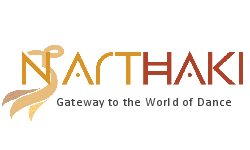
|   |

|   |
Natmandir welcomes the Bengali New Year with dance and music - Dr. Nita Vidyarthi e-mail: nitavidyarthi@gmail.com Photos: Anudeepa May 28, 2025 Natmandir, a premiere performing arts institution, presented an evening of dance and music welcoming "Poila Baishak" / Naba Borsho, the Bengali New Year, recently at the Gyan Manch, Kolkata. Curated by Kathak exponent Anurekha Ghosh, the Founder Director of the institution, the program titled 'Aamar Ma' was a tribute to her mother who inspired her to the world of dance and music, to be trained well and become a proficient dancer. The program was presented in three sections commencing with a solo recital by Anurekha, followed by solos of two of her students, 'Guru-Shishya Parampara' showcasing the different elements of the Lucknow gharana by the students of Natmandir and a collage 'Prathama Aad Shiva Shakti' garlanded with songs of Tagore, mainly from the prakriti (Nature) section featuring the disciples of Anurekha. Incidentally, Anurekha is trained in Rabindrasangeet, being the disciple of the renowned singer Swagatalakshmi Dasgupta and in this evening, essayed her multifaceted roles of a dancer, teacher and choreographer diligently. 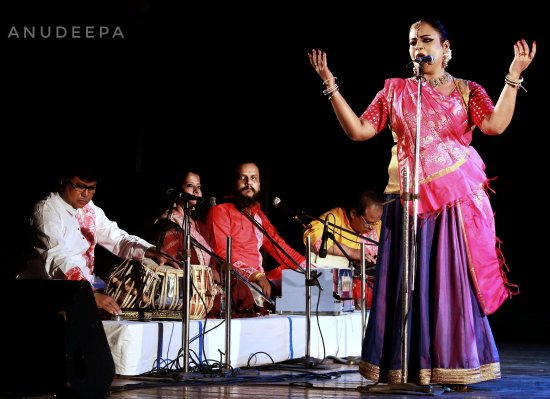 Anurekha Ghosh The evening began with a solo Kathak recital with the distinctive style of the Lucknow gharana by Anurekha Ghosh with live music accompaniment by musicians Pratik Mukherjee on the tabla, Sunando Mukherjee on the sarod, Dr. Arindam Bhattacharya on the vocals and Kathak dancer Arunima Sengupta on the bol paranth. A Kathak recital these days has done away with the traditional 'salami', meaning salutation, which was usually presented with or immediately after the Amad. However, Kathak dancers nowadays are inclined to begin with an invocation before presenting the pure dance elements of the dance form. So, after sharing a few words making herself (and her mother) more familiar to her audience, Anurekha began with Adi Shankaracharya's Krishnashtakam "Bhajey vrajaika mandanam samasta papa khandanam". The elaborate 8 versed presentation replete with crisp motifs, some gentle some vigorous, of the Lucknow gharana that she had learnt from her different Gurus, merged to a soulful conclusion with "Hari tum haro". Her rendition ran the projection in dance of a Shloka with adoration and an effective blend of diverse effects of chiselled movements, gestures and elegance of the Lucknow gharana vivifying a lofty import of the piece. To show her technical prowess, she began with Teen Taal vilambit Thaat, Upaj and Uthan as a prelude with a rhythmic introduction, setting the mood and tone with a mellifluous prelude on the sarod by none other than the acclaimed Sunando Mukherjee, exploring the different fractions of the tala with the 'sangat' of the noted tabaliya Pratik Mukherjee. A handful of small bandishes and then the wizardry on rhythm came to the fore with 'sade das matra' (ten and a half matra). She enthralled by her performance of 'intra-forms' of abstract nature on mnemonic syllables of infinite variety and adopted the unique style of landing pat on the sam with a body and hand slant, that reflected the glimpse of her Gurus Nahid Siddiqui and Durga Arya. Her fleeting tatkars and paltas offering scintillating patterns of sound imagery by maneuvering the cadence of her ankle bells with the pace of her footwork while gradually walking towards her musicians for a friendly "technical" conversation, was highly enjoyable as she unleashed a crescendo with her ankle bells to a whispering tintinnabulation of just a single bell before breaking into a laughter shared with her accompanists. Enjoyable indeed was her subsequent smart chakkars and tihais that adorned her tukras and torhas to land onto a final poised stance. It showed the technical virtuosity of an experienced and mature dancer and a performer with immaculate 'taiyari'. A glimpse of "Bhava Pradhan" Kathak showcasing the 'Holi Khela' (playing Holi) of Radha and Krishna composed by Guru Durga Arya was entertaining for its content. But what touched the heart was the soul-stirring concluding title piece, "Sandhya holo go Maa - O Maa bukey tuley nayo" (It's evening Mother, hold me onto yourself) set to Tagore's song from the Puja Section - subsection Viraha - in Ektaal and raag Iman Purvi from Geetimallya, composed by the Bard at Ramgarh, on the foothills of Himalayan Uttarakhand. Many things in Art are symbolic and this song, sung passionately by Arindam Bhattacharya was the perfect choice for the occasion to long for the warm touch of a mother. This presentation was supported by a video on the backdrop where Anurekha, bewildered and pain-stricken, seeks her mother. The dancer signed off on a poignant note leaving the audience in the paradox of inevitability. 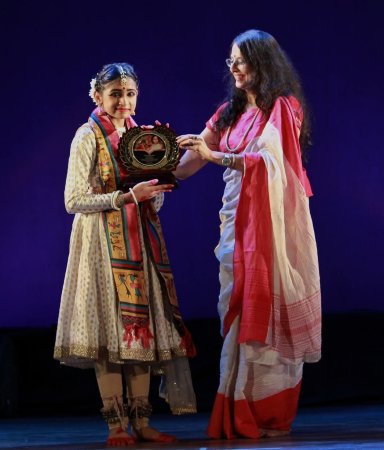 Dibyanshi Biswas and Alokparna Guha The 'Mancha Pravesh' of Dibyanshi Biswas, a twelve year old talented disciple of Anurekha Ghosh, who has been learning from her from the age of four was celebrated next, with about a forty minute recital of nritta beginning with teen taal vilambit only with the theka of the tabla and nagma and bol paranth by Anurekha. The promising young dancer has tremendous tenacity for her age, evident from her strength in the rendition of tatkaar and was awarded the first Swapna Ghosh Memorial Scholarship introduced by Natmandir and Anurekha Ghosh in the memory of her mother from this year onwards. The investiture was executed by acclaimed senior Kathak dancer Alokparna Guha by presenting Dibyanshi with a memento. The second segment 'Guru Shishya Parampara' featuring the Natmandir students of Anurekha Ghosh commenced with the Guru Vandana Shloka, "Guru Brahma Guru Vishnu", followed by a smart solo by Rishita Maitra, an intermediate student of the institution, in Jhaptaal and in the Dhamar taal, displaying a fine sense of technique, especially layakari and feel for the presentational aesthetic features of her Guru. A choc-o-bloc presentation of the various elements of Kathak were performed by a brigade of about 70 dancers of Natmandir, in batches from beginners, the tiny-tots to seniors displaying the subtly nuanced wizardry of rhythms of the Lucknow gharana including a sterling nritta presentation of the 'Panchamsawari' by the seniors. A Tarana in raag Rageshree, teen taal, needs mention. The adult intermediate group deserves praise for exhibiting discipline, teamwork and skill in rendition of the various numbers while keeping a tight grip on their individual performances till the finish. About thirty odd toddlers under the instruction of Anurekha on the stage showed their tehzeeb in following the instruction of their Guru in teental with attention providing entertainment to the audience. 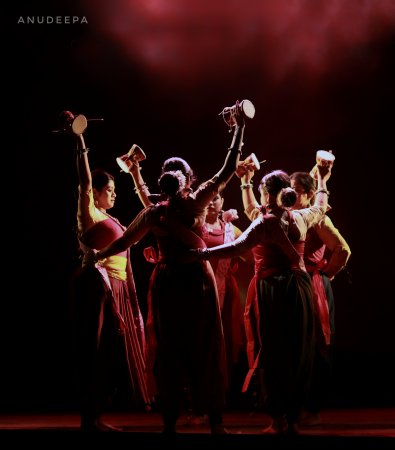 Prathama Aad Shiva Shakti The concluding collage (Rabindranritya) commenced with the screen on the backdrop reflecting the image of Lord Nataraja in a meditative posture while a group of five playing the damaru set to the dhrupad "Prathama Aad Shiva Shakti" entered and occupied centre-stage to form a circle dancing with the recorded dhrupad. This was followed by the narration and choreographic offering set to five songs of Tagore supported by videos on the backdrop. The crystalline linear geometrics and the stretched hand movements, sometimes vigorous, repeated in the choreography, together with the literal imagery of the lyrics of the songs jarred. The feeling for the over-dramatic articulation of the narration in "Oi je tini Oije tini" (look he's there!) as a prelude to the song "Udiye dwaja abhravedir rathey", a number usually sung in Independence Day celebrations or patriotic occasions was startling and so was the rendition of the guest Odissi dancer Oishika Das who is yet to acquire style. 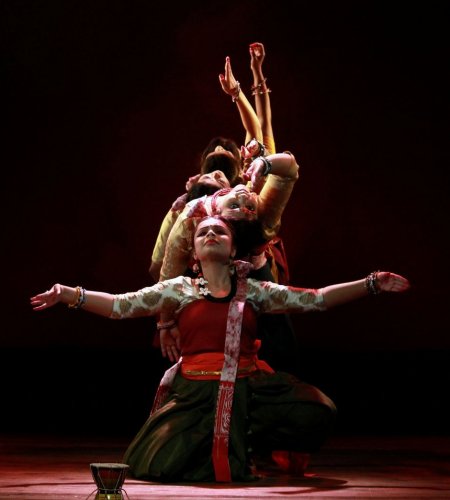 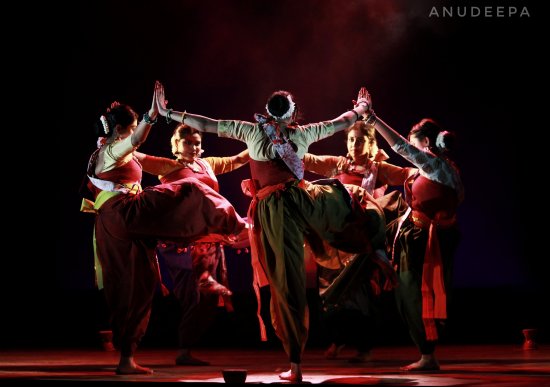 Rabindranritya by Natmandir dancers Dancing was overpowered by the soulful singing of the celebrated Swagatalakshmi Dasgupta. This segment was foggy in parts with the long narrations blurring the focus. With most of Anurekha's recent sunlit productions, this particular segment could be thoughtfully reworked to reach her high standard of presentations. Aklanta Majumder was her usual best in steering the program as a compere to the finale where the whole contingent danced merrily on stage with their Guru Anurekha Ghosh. 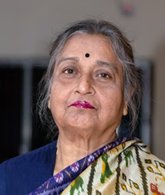 Dr. Nita Vidyarthi is a veteran critic of performing arts and writes on dance, music and theatre in leading publications. |